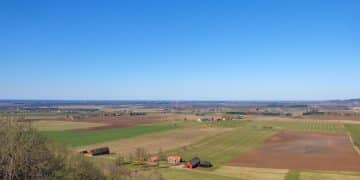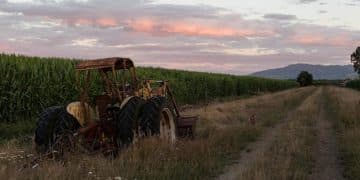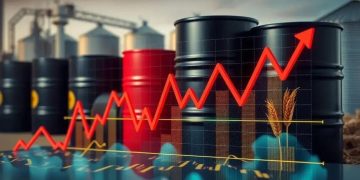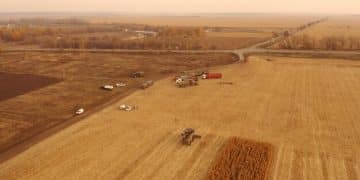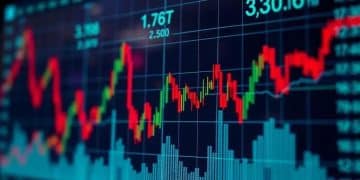US Agricultural Commodity Futures: 2025 Market Signals & Risk Management
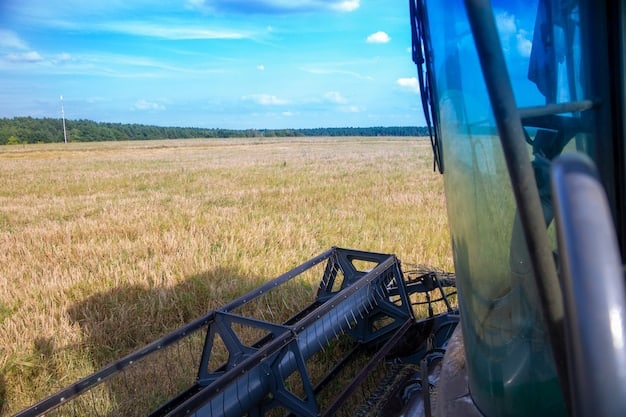
US Agricultural Commodity Futures in 2025 require a keen understanding of evolving market signals and robust risk management strategies amidst fluctuating global conditions and technological advancements affecting agricultural production and trade.
Navigating the complexities of US Agricultural Commodity Futures: How to Interpret Market Signals and Manage Risk in 2025 requires a proactive approach and a deep understanding of the factors influencing the agriculture sector. Understanding these futures can be a game-changer for farmers, investors, and anyone involved in the agricultural supply chain.
Understanding US Agricultural Commodity Futures
US agricultural commodity futures are standardized contracts to buy or sell a specific quantity of an agricultural product at a predetermined future date and price. These futures are traded on exchanges like the CME Group (Chicago Mercantile Exchange) and are used by various participants in the agricultural industry.
Understanding the mechanics of agricultural commodity futures is vital for effective risk management and strategic decision-making. This section will delve into the basics, providing a solid foundation for participants to navigate this complex market.
Key Participants in the Futures Market
Understanding who is involved helps clarify market dynamics.
- Hedgers: Agricultural producers and processors use futures to mitigate price risk.
- Speculators: Traders who aim to profit from price movements.
- Arbitrageurs: Exploit price discrepancies between different markets.
Role of Exchanges
Exchanges such as the CME Group provide a regulated platform for trading futures contracts.
- Price Discovery: Futures markets facilitate transparent price discovery through open trading.
- Standardization: Contracts are standardized in terms of quantity, quality, and delivery location.
- Clearinghouse: Guarantees the financial integrity of transactions.
Agricultural commodity futures serve as vital tools for price discovery, risk management, and investment in the agricultural sector. Their efficient functioning is crucial for the stability and growth of US agriculture.
Interpreting Key Market Signals in 2025
Interpreting market signals is crucial for making informed decisions in the agricultural commodity futures market. These signals can be derived from a variety of sources, reflecting both supply-side and demand-side factors.
In 2025, several key indicators will shape the landscape of agricultural commodity futures, requiring a strategic approach to analysis and interpretation.

Weather Patterns and Climate Change
Weather conditions have a direct impact on crop yields and agricultural production.
- Droughts: Extended periods of low rainfall can severely reduce crop yields.
- Floods: Excessive rainfall can damage crops and disrupt planting and harvesting.
- Temperature Extremes: Unusually high or low temperatures can affect crop development.
Geopolitical Events
Geopolitical events can disrupt supply chains and impact agricultural commodity prices.
- Trade Wars: Import and export tariffs can influence global trade flows.
- Political Instability: Conflicts or political unrest in key agricultural regions can disrupt production.
- Government Policies: Subsidies, regulations, and trade agreements can shape market dynamics.
Economic Indicators
Macroeconomic factors play a significant role in determining demand for agricultural commodities.
- GDP Growth: Economic expansion typically leads to increased demand.
- Inflation: Rising prices can impact consumer spending and demand for agricultural products.
- Interest Rates: Higher interest rates can increase borrowing costs for farmers and processors.
By closely monitoring these market signals, participants in the agricultural commodity futures market can gain valuable insights and make more informed trading decisions.
Risk Management Strategies for Agricultural Futures
Effective risk management is essential for participants in the agricultural commodity futures market. The inherent volatility of agricultural prices, combined with the leverage offered by futures contracts, necessitates a robust risk management framework.
Successful risk management not only protects capital but also enhances the ability to achieve consistent profitability.
Hedging Strategies
Hedging involves using futures contracts to offset price risk in the physical market.
- Short Hedging: Producers sell futures to lock in a price for their crops.
- Long Hedging: Processors buy futures to secure the future cost of raw materials.
Diversification
Diversifying a portfolio across multiple agricultural commodities can reduce overall risk.
- Correlation Analysis: Understanding the correlation between different commodities is key to effective diversification.
- Portfolio Allocation: Distributing investments across different commodities can limit exposure to any single market.
Stop-Loss Orders
Stop-loss orders automatically exit a position if the price moves against you beyond a predetermined level.
- Setting Stop-Loss Levels: Determining appropriate stop-loss levels is crucial for protecting capital.
- Monitoring Positions: Regularly reviewing and adjusting stop-loss levels based on market conditions.
Employing these risk management strategies can help participants navigate the complexities of the agricultural commodity futures market and protect their investments from adverse price movements.
Technological Advancements and Their Impact
Technological advancements are rapidly transforming the agricultural sector and, consequently, the agricultural commodity futures market. Innovations in precision farming, data analytics, and trading platforms are enhancing efficiency, transparency, and decision-making.
Understanding these technological trends is crucial for participants seeking to stay ahead in the market.

Precision Farming
Precision farming technologies enable farmers to optimize resource utilization and improve crop yields.
- GPS Technology: Used for precise planting, fertilization, and harvesting.
- Remote Sensing: Drones and satellites provide real-time data on crop health and soil conditions.
- Variable Rate Application: Applying inputs based on specific needs of different areas of the field.
Data Analytics
Data analytics tools help in forecasting crop yields, predicting market trends, and managing risk.
- Machine Learning: Algorithms that analyze large datasets to identify patterns and predict future outcomes.
- Weather Forecasting: Advanced weather models provide more accurate predictions of weather patterns.
- Supply Chain Optimization: Streamlining logistics and reducing waste through data-driven insights.
Trading Platforms
Advanced trading platforms offer real-time market data, analytical tools, and automated trading capabilities.
- Algorithmic Trading: Using computer programs to execute trades based on predefined rules.
- High-Frequency Trading: Executing a large number of orders at very high speeds.
- Mobile Trading: Accessing market data and executing trades from mobile devices.
Technological advancements are revolutionizing the agricultural commodity futures market by improving efficiency, enhancing transparency, and enabling more informed decision-making. Participants who embrace these technologies will be better positioned to succeed in the evolving landscape.
The Role of Government Regulations
Government regulations play a crucial role in shaping the agricultural commodity futures market. These regulations aim to ensure fair trading practices, protect market participants, and maintain the integrity of the market.
Staying informed about regulatory changes and their potential impact is essential for compliance and strategic planning.
The Commodity Futures Trading Commission (CFTC)
The CFTC is the primary regulatory agency for the US commodity futures market.
- Oversight: The CFTC oversees trading and enforcement activities on futures exchanges.
- Regulation: Sets rules and regulations to prevent fraud, manipulation, and abusive trading practices.
- Enforcement: Investigates and prosecutes violations of the Commodity Exchange Act.
Farm Bills
Farm bills are comprehensive pieces of legislation that address a wide range of agricultural issues.
- Commodity Programs: Provide support for agricultural producers through price supports, subsidies, and insurance programs.
- Conservation Programs: Promote sustainable farming practices and environmental stewardship.
- Trade Policies: Influence international trade flows and market access for US agricultural products.
International Trade Agreements
International trade agreements can have a significant impact on the agricultural commodity futures market.
- Tariffs: Taxes on imported goods can affect the competitiveness of US agricultural products in foreign markets.
- Quotas: Limits on the quantity of goods that can be imported or exported.
- Sanctions: Trade restrictions imposed on specific countries can disrupt supply chains and impact prices.
Government regulations are a critical factor in the agricultural commodity futures market. Participants must stay abreast of regulatory changes and their potential impact to ensure compliance and make informed decisions.
Future Outlook for US Agricultural Commodity Futures in 2025
Looking ahead to 2025, the US agricultural commodity futures market is poised to undergo further transformation driven by several key trends. These trends include evolving consumer preferences, increased focus on sustainability, and continued technological innovation.
Understanding these trends will be essential for participants looking to navigate the market successfully.
Evolving Consumer Preferences
Consumer demand for sustainably produced, organic, and plant-based foods is growing.
- Organic Farming: Increasing demand for organic agricultural products.
- Plant-Based Diets: Growing interest in plant-based alternatives to meat and dairy products.
- Sustainable Agriculture: Consumer preferences for environmentally friendly farming practices.
Increased Focus on Sustainability
Sustainability is becoming an increasingly important factor in the agricultural sector.
- Carbon Sequestration: Farmers are adopting practices to reduce greenhouse gas emissions and sequester carbon in the soil.
- Water Conservation: Efforts to reduce water usage and improve water quality in agricultural production.
- Biodiversity: Promoting biodiversity in agricultural landscapes.
Continued Technological Innovation
Technological innovation will continue to drive efficiency and productivity gains in agriculture.
- Artificial Intelligence: AI-powered tools for crop monitoring, disease detection, and yield forecasting.
- Biotechnology: Genetically modified crops with improved yields, pest resistance, and drought tolerance.
- Automation: Use of robots and automated systems in planting, harvesting, and processing.
The future of US agricultural commodity futures in 2025 will be shaped by evolving consumer preferences, increased focus on sustainability, and continued technological innovation. Participants who anticipate and adapt to these trends will be best positioned to thrive in the market.
| Key Point | Brief Description |
|---|---|
| 🌱 Weather Patterns | Impact crop yields and prices significantly. Monitor droughts, floods, and temperature extremes. |
| 🌍 Geopolitical Events | Influence trade flows and market stability. Trade wars, instability, and policies matter. |
| 📊 Economic Indicators | Affect demand for agricultural products. Watch GDP growth, inflation, and interest rates. |
| 🤖 Technology | Precision farming, data analytics, and trading platforms enhance efficiency and decision-making. |
Frequently Asked Questions
They are contracts to buy or sell specific quantities of agricultural products at a predetermined date and price, traded on exchanges like the CME Group, used for price discovery and risk management.
Weather directly impacts crop yields. Monitoring droughts, floods, and temperature extremes helps predict supply changes and price movements. Accurate data is key for informed decisions.
Geopolitical events like trade wars and political instability can disrupt supply chains, leading to price volatility. Government policies also shape market dynamics, so stay informed.
Hedging, diversification, and stop-loss orders are vital. Hedging offsets price risk, diversification spreads risk, and stop-loss orders limit potential losses. Always protect your capital.
Precision farming, data analytics, and advanced trading platforms will enhance efficiency and decision-making. Embrace these innovations to stay competitive and optimize your trading strategies.
Conclusion
In conclusion, navigating the intricacies of the US Agricultural Commodity Futures market in 2025 requires a blend of strategic foresight, technological acumen, and a deep understanding of both market signals and risk management practices. By staying informed and adaptable, participants can effectively manage risks and capitalize on emerging opportunities, ensuring long-term success in the dynamically evolving agricultural landscape.

